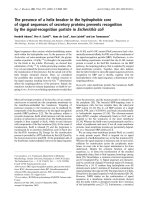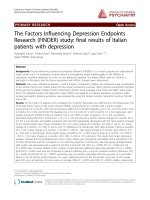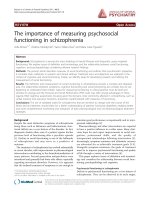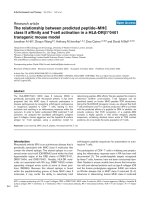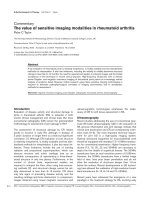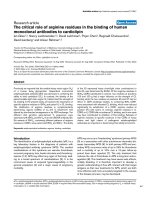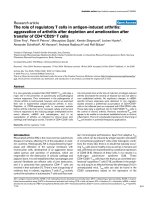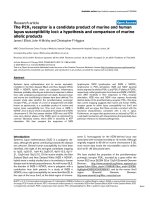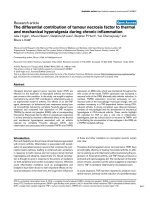Báo cáo y học: "The TGF-beta-Pseudoreceptor BAMBI is strongly expressed in COPD lungs and regulated by nontypeable Haemophilus influenzae" doc
Bạn đang xem bản rút gọn của tài liệu. Xem và tải ngay bản đầy đủ của tài liệu tại đây (1.08 MB, 9 trang )
Drömann et al. Respiratory Research 2010, 11:67
/>Open Access
RESEARCH
BioMed Central
© 2010 Drömann et al; licensee BioMed Central Ltd. This is an Open Access article distributed under the terms of the Creative Commons
Attribution License ( which permits unrestricted use, distribution, and reproduction in
any medium, provided the original work is properly cited.
Research
The TGF-beta-Pseudoreceptor BAMBI is strongly
expressed in COPD lungs and regulated by
nontypeable
Haemophilus influenzae
Daniel Drömann*
1
, Jan Rupp
1,2
, Kristina Rohmann
1
, Sinia Osbahr
1
, Artur J Ulmer
3
, Sebastian Marwitz
4
,
Kristina Röschmann
3
, Mahdi Abdullah
4
, Holger Schultz
4
, Ekkehard Vollmer
4
, Peter Zabel
1,5
, Klaus Dalhoff
1
and
Torsten Goldmann
4
Abstract
Background: Nontypeable Haemophilus influenzae (NTHI) may play a role as an infectious trigger in the pathogenesis
of chronic obstructive pulmonary disease (COPD). Few data are available regarding the influence of acute and
persistent infection on tissue remodelling and repair factors such as transforming growth factor (TGF)-β.
Methods: NTHI infection in lung tissues obtained from COPD patients and controls was studied in vivo and using an in
vitro model. Infection experiments were performed with two different clinical isolates. Detection of NTHI was done
using in situ hybridization (ISH) in unstimulated and in in vitro infected lung tissue. For characterization of TGF-β
signaling molecules a transcriptome array was performed. Expression of the TGF-pseudoreceptor BMP and Activin
Membrane-bound Inhibitor (BAMBI) was analyzed using immunohistochemistry (IHC), ISH and PCR. CXC chemokine
ligand (CXCL)-8, tumor necrosis factor (TNF)-α and TGF-β expression were evaluated in lung tissue and cell culture
using ELISA.
Results: In 38% of COPD patients infection with NTHI was detected in vivo in contrast to 0% of controls (p < 0.05).
Transcriptome arrays showed no significant changes of TGF-β receptors 1 and 2 and Smad-3 expression, whereas a
strong expression of BAMBI with upregulation after in vitro infection of COPD lung tissue was demonstrated. BAMBI was
expressed ubiquitously on alveolar macrophages (AM) and to a lesser degree on alveolar epithelial cells (AEC).
Measurement of cytokine concentrations in lung tissue supernatants revealed a decreased expression of TGF-β (p <
0.05) in combination with a strong proinflammatory response (p < 0.01).
Conclusions: We show for the first time the expression of the TGF pseudoreceptor BAMBI in the human lung, which is
upregulated in response to NTHI infection in COPD lung tissue in vivo and in vitro. The combination of NTHI-mediated
induction of proinflammatory cytokines and inhibition of TGF-β expression may influence inflammation induced tissue
remodeling.
Introduction
Pulmonary presence of nontypeable Haemophilus influ-
enzae (NTHI) has been implicated as an important infec-
tious trigger in chronic obstructive pulmonary disease
(COPD) [1]. New acquired NTHI strains isolated from
patients with exacerbations of COPD appear to be one
mechanism underlying recurrent exacerbations of
chronic obstructive pulmonary disease since they induce
more airway inflammation and likely have differences in
virulence compared with colonizing strains [2]. Change
in bacterial load alone is unlikely to be an important
mechanism for exacerbations [3].
Bacterial infection is not only associated with advanced
airway inflammation and increased frequency of exacer-
bations but also related to accelerated decrease in lung
function, which suggests a role of bacterial pathogens in
the progression of COPD [4].
* Correspondence:
1
Medical Clinic III, University of Schleswig-Holstein, Campus Lübeck, 23538
Lübeck, Germany
Full list of author information is available at the end of the article
Drömann et al. Respiratory Research 2010, 11:67
/>Page 2 of 9
The pulmonary inflammatory response is a critical ele-
ment of the host defense to infection and initiates tissue
repair to return the organ to normal function. However,
an accurate balance between host defense and inappro-
priate tissue damage is essential. Under the conditions of
repeated cycles of infection this balance is frequently
challenged [5].
Inflammation induces subsequent release of repair fac-
tors, such as vascular endothelial growth factor, keratino-
cyte growth factor and transforming growth factor-β
(TGF-β). Uncontrolled or prolonged repair function and
matrix deposition leads to fibrosis, whereas unopposed
tissue destruction can cause damage of the alveolar wall
with development of emphysema [6]. TGF-β functions as
a central regulator that induces tissue remodeling and
repair. In experimental models TGF- signaling is neces-
sary for the induction of fibrosis after inflammatory
insults [7]. In addition, TGF-β has important immuno-
modulating effects [8,9].
To characterize regulation of TGF-β signaling mole-
cules by NTHI infection we performed a transcriptome
array in an ex vivo infection model of human lung tissue.
One of the genes strongly upregulated upon infection
was the TGF-β-pseudoreceptor BMP and activin mem-
brane-bound inhibitor (BAMBI). The BAMBI gene
encodes a 260 amino acid transmembrane glycoprotein
which is highly evolutionary conserved in vertebrates
[10] and is related to the TGF-β family type I receptors.
BAMBI is induced by members of the TGF- family and β-
catenin [11] and functions as a negative regulator of TGF-
β signaling by acting as a pseudoreceptor [12]. A role of
BAMBI in lipopolysaccharide mediated hepatic fibrosis
has been suggested recently [13]. However expression
and function of BAMBI in the lung has not been
described up to now.
Due to the central role of TGF-β as a regulator of
inflammation and repair the aim of this study was to
characterize the expression of BAMBI in the human lung
and to investigate the influence of NTHI infection as a
common trigger of inflammation in COPD on the regula-
tion of the pseudoreceptor.
NTHI infection was studied in vitro using a human
lung tissue infection model. Persistent infection was eval-
uated using lung tissue obtained from COPD patients
without evidence of acute infection.
Subjects and methods
Study protocol
NTHI infection in lung tissues obtained from COPD
patients and controls was studied ex vivo. Detection of
NTHI was done using nested-PCR and in situ hybridiza-
tion (ISH) in unstimulated and in ex vivo infected lung
tissue by using an acute NTHI infection model which was
previously described using other microorganisms [14,15].
This study was approved by the ethical committee of the
University of Lübeck (reference number 03/158) and is in
compliance with the Helsinki declaration.
Lung tissues
Lung tissue preparation was done as previously described
[15]. Briefly, the specimens were tumor-free material at
least 5 cm away from the tumor front. For ex vivo infec-
tion experiments lung specimens (1 cm
3
size) were cul-
tured in RPMI1640 medium (Sigma, Taufkirchen,
Germany) at 37°C and 5% CO
2
for 24 h and incubated
with 500 μl NTHI suspensions (10
7
CFU/ml) or medium
[14]. Tissues were fixed using the HOPE (Hepes glutamic
acid buffer mediated Organic solvent Protection Effect)
technique [16]. Viability of tissue was assessed by LDH
assay and showed no significant increase during an incu-
bation period of up to 48 h (data not shown).
Culture and characterization of NTHI
The NTHI strains used in this study were clinical isolates
from the University Hospital in Luebeck. Strain 1
(defined as NTHI-1) was an isolate from a COPD patient
with invasive, pneumonic disease, whereas strain 2
(defined as NTHI-2) was a noninvasive respiratory isolate
from a patient without COPD. Both strains were charac-
terized by biochemical assays (API-NH, Fa. BioMeriéux,
Nürtingen, Germany), the requirement of factor × and V
for bacterial growth, and negative slide serum agglutina-
tion tests. Sequencing of the 16 S rRNA gene region
revealed the Rd KW20 NTHI strain in both cases. For the
experiments, NTHi were grown overnight on chocolate
agar at 37°C and 5% CO
2
. The working solution was
adjusted to 1.2 × 10
9
bacteria/ml using densitometry.
Transcriptome array
Total RNA was extracted from HOPE-fixed, paraffin-
embedded lung tissues which were in vitro infected with
NTHI or subjected to medium only [17]. To identify reg-
ulation of TGF-β signaling molecules induced by NTHI a
44 k transcriptome array was used (Agilent, Böblingen,
Germany, [18]). As a usual procedure with this array for-
mat the expression values were quantile-normalized [18].
We compared the log-ratios of expression in infected and
not infected lung tissues from the same donors.
Immunohistochemical staining (IHC)
Primary antibodies (BAMBI; mouse anti human, eBiosci-
ence, San Diego, USA; TGF-β, rabbit anti human, Abcam,
Cambridge, UK) were applied in a dilution of 1/100 as
described elsewhere [19]. Identification of cell types was
performed morphologically by lung pathologists and vali-
dated by immunohistochemistry using expression of
CD68 for macrophages and of SP-A for alveolar epithelial
cells type II; Bronchial epithelia were identified by their
morphology.
Drömann et al. Respiratory Research 2010, 11:67
/>Page 3 of 9
In total we analyzed 48 samples from COPD lungs
including 10 samples of in vitro infected lung specimens.
In addition 11 samples from patients without COPD were
analyzed.
ISH
For targeting NTHI by a specific DNA-probe, a 146 bp
(Rd KW20) sequence was amplified using the following
primers for: TCG CTG ATT TTC CCG GTT TA, rev:
TAG CAA GCA AAG ATT GCT CC fragment was car-
ried out overnight in moist chambers at 46°C. For target-
ing BAMBI mRNA the following primers were used
(Bambi for: CAG CTA CAT CTT CAT CTG GC; Bambi
rev: AGA AGT CTA GAG AAG CAG GC), which span
an amplicon of 152 bp and were also used for RT-PCR.
Probes were generated and hybridized like previously
described [14,17]. Sequencing was performed to verify
the specificity of the RT-PCR. All samples were analyzed
by two independent investigators (TG and DD).
Real-time polymerase chain reaction (RT-PCR) of Bambi
mRNA expression
RT-PCR was performed using NucleoSpin RNA II kit
(Macherey-Nagel, Dueren, Germany) and reverse tran-
scribed into cDNA (Roche First- Strand PCR kit, Man-
nheim, Germany), PCR amplification was performed
using LightCycler
®
Detection System (Roche Molecular
Biochemicals, Penzberg, Germany). Conventional RT-
PCR was performed as previously reported [17] and the
results were normalized to GAPDH.
Cytokine assays
Measurement of CXC chemokine ligand (CXCL)-8,
tumor necrosis factor (TNF)-α and TGF-β levels in
supernatants was performed using commercially avail-
able ELISA kits (Biosource, Solingen, Germany).
Western Blot
Lung homogenates and cell pellets were lysed, subjected
to 12% SDS-PAGE, and blotted on nitrocellulose mem-
brane (Sartorius, Goettingen, Germany). Immunodetec-
tion of phosphorylated p38 MAPK was performed with
specific antibodies (Cell Signaling Technology, Beverly,
USA).
Bronchoscopy and isolation of BAL cells
Bronchoscopically guided lavage and isolation of AM was
performed as described previously [20].
Statistical analysis
Data are presented as the mean ± SD. Statistics were per-
formed with non-parametric tests. For independent sam-
ples Student's t test was used. For categorical variables 2/
2 tables were analysed using chi square test. p values >
0.05 were considered statistically significant. Calculations
were carried out with Statistica TM for Windows (version
5), 1997.
Results
Patients and lung tissue
The study population consisted of 48 COPD patients
(mean age 63 years, 34 males, 14 females) who had an
indication for lung surgery of peripheral nodules (table
1). No patient had undergone antimicrobial treatment
before the operation. Systemic steroid treatment was
administered preoperatively in 13/48 patients in doses <
20 mg/d of prednisone equivalent.
11 patients without chronic airway diseases served as
controls (mean age 59 years, 6 male, 5 female). Lung tis-
sue samples were obtained from lobectomy or atypical
resections (COPD patients: lung cancer: n = 39, metasta-
ses of extrapulmonary tumors: n = 6, benign nodules: n =
3; controls: n = 11, lung cancer: n = 2, metastases of extra-
pulmonary tumors: n = 7, benign nodules: n = 2).
The patterns of infected cells vary between in vitro and in
vivo infection with NTHI
38% (n = 18/48) of COPD lung tissue proved to be NTHI-
DNA positive as detected by PCR. Results of the PCR
were all confirmed in the ISH. We found no significant
differences of infection rates between the different stages
of disease (Table 1). NTHI-DNA negative lungs did not
show positive signals using ISH. On the cellular level an
Table 1: Demographic data and NTHI detection in lung tissues from COPD patients and controls.
Study group
Treatment
n pack years NTHI detection Steroid
PCR ISH
COPD 48 18 (38%)* 18*
GOLD I 12 62 [28-145] 4 (33%) 4
GOLD II (n = 8) 18 67 [34-160] 6 (33%) 6 systemic
GOLD III (n = 8) 18 56 [25-120] 8 (44%) 8 inhalative (n = 8)
systemic
Controls 11 0 0 0 inhalative (n = 6)
*p < 0.05 compared to controls (Chi square); ISH = in situ hybridization, NTHI = nontypeable Haemophilus influenzae
Drömann et al. Respiratory Research 2010, 11:67
/>Page 4 of 9
infection rate (determined by evaluation of positive ISH-
staining) of 40-50% in AM and 35-45% in alveolar epithe-
lial cells (AEC) was observed in infected COPD lungs
(figure 1). In contrast, after acute in vitro infection with
strain NTHI-1 and NTHI-2 a different infection pattern
was found with infection rates of AM in 60-75% and of
AEC in 15-25% (figure 2). In addition, in tissue samples
representing bronchial epithelial cells (BEC) we found
intense positive staining of these cells targeting NTHI
infection in vivo and in vitro using ISH (figure 1d and 2c).
In lung tissues of patients without COPD we did not
detect NTHI using both PCR and ISH (p < 0.05, table 1).
Modulation of TGF-β signalling by infection with NTHI
To characterize regulation of TGF-β signaling molecules
by NTHI a transcriptome array of in vitro infected COPD
lung tissue was performed (n = 5). Data of the array
showed no significant changes of TGF-β receptors and
Smad-3 expression. Regarding TGF-β expression we
found a moderate increase, whereas a strong expression
of BAMBI with 3-fold increase after in vitro infection of
COPD lung tissue was demonstrated (figure 3).
NTHI induced host response
Measurement of cytokine concentrations from superna-
tants of in vitro infected lung tissue (NTHI-1 and NTHI-
2) revealed a strong proinflammatory response with
increased expression of CXCL-8 and TNF-α (figure 4a
and 4b). Furthermore infection led to increased expres-
sion of the MAP-kinase p38, which is demonstrated in
figure 4c and 4d. Inhibition of p38 significantly inhibited
CXCL-8 and TNF-α expression (p < 0.01). NTHI infec-
tion of lung tissues (NTHI-1 and NTHI-2) and A549 cells
generated a significant decrease of TGF-β release in the
supernatant (p < 0.05 and p < 0.01, figure 4e and 4f). A
reduction of TGF-β expression in infected lung tissue was
also observed using IHC (figure 4g and 4h).
BAMBI is strongly upregulated in lung tissue in response to
NTHI infection in vivo and in vitro
BAMBI was expressed ubiquitously on AM and to a
lesser degree on AEC. This was demonstrated using IHC
Figure 1 In situ hybridization targeting NTHI in persistently in-
fected COPD lung tissue. AM (A, 400×; B, 600×), AEC (C, 600×) and
bronchial epithelial cells (D, 600×). AM = alveolar macrophages, AEC =
alveolar epithelial cells. Aminoethylcarbazole was used as a color sub-
strate, which results in red signals. Signals are also indicated by arrows.
Figure 2 In situ hybridization targeting NTHI in in vitro infected
human lung tissue (Aminoethylcarbazole, red signals). Signals are
also indicated by arrows. Positive staining of AM (A, 400×), AEC (B,
400×) and bronchial epithelial cells (C, 400×), control (D, 400×). NTHI-1
infection was primarily detected in AM (figure a) and to a lesser degree
also in AEC (figure 2b). Similar results were seen with NTHI-2 (demon-
strated for AM [E, 600×], control [F, 600×]). AM = alveolar macrophages,
AEC = alveolar epithelial cells.
Figure 3 Transcriptional levels of different molecules involved in
TGF-β signalling after NTHI stimulation (C = control, S = NTHI-
stimulated) obtained by transcriptome arrays.
Drömann et al. Respiratory Research 2010, 11:67
/>Page 5 of 9
Figure 4 Expression of CXCL-8 (A) and TNF-α (B) in supernatant of human lung tissue after in vitro infection with NTHI-1 and NTHI-2. Signals
are indicated by arrows. Expression of pp38 in human lung tissue (C: IHC, 400×; D: Western Blot). TGF-β expression in supernatant of in vitro infected
human lung tissue with NTHI-1 and NTHI-2 (E) and A549 cells (F). IHC of TGF-β in human lung tissue without (G, 400×) and with (H, 400×) NTHI-1 in
vitro infection. SB (203580) = p38 MAPK inhibitor; IHC = Immunohistochemistry, NTHI-1, n = 6; NTHI-2, n = 5; * = p < 0.01, + = p < 0.05.
Drömann et al. Respiratory Research 2010, 11:67
/>Page 6 of 9
and ISH and was confirmed by RT-PCR and sequencing.
Using IHC on isolated AMs a typical membrane-bound
pattern is demonstrated (figure 5a and 5b).
In vitro infection revealed that NTHI induces a strong
upregulation of BAMBI in the lung tissue on AM and
AEC as well as on isolated AM and A549 cells. This was
demonstrated on RNA and protein level (figure [5band
5d] and 6[a-d]). This induction was observed uniformly
among the different lung tissues, cells and cell lines
tested. In vivo NTHI-infected lung tissue of COPD
patients showed also a stronger expression of BAMBI on
AM and AEC compared to lung tissue without NTHI
Figure 5 Expression of BAMBI in isolated AM and alveolar epithelial cells (Aminoethylcarbazole color substrate, results in red signals). A:
unstimulated AM (600×), B: NTHI-1 stimulated AM (600×), C: control (600×). D: mRNA expression of BAMBI in AM (normalized to GAPDH). E: Expression
of Bambi on A549 cells (red area: isotype control). AM = alveolar macrophages. n = 4.
Drömann et al. Respiratory Research 2010, 11:67
/>Page 7 of 9
infection and control tissue (figure 6e and 6f). However,
there was no correlation with the different GOLD-
classes. Figure 7 demonstrates the increased expression
of BAMBI on the RNA level in in vitro infected lung tis-
sue.
Discussion
In the present study we demonstrate for the first time the
expression of the TGF pseudoreceptor BAMBI in the
human lung. COPD patients with NTHI infection
showed increased expression of BAMBI in the lung tis-
sues when compared to non-infected patients. Further-
more we show the upregulation of the pseudoreceptor by
in vitro infection using two different NTHI strains in
combination with a strong proinflammatory response
and decreased expression of TGF-β.
The characterization of BAMBI adds a new mechanism
to the complex regulation of TGF-β in the human lung.
Recently the pseudoreceptor, which is able to inhibit
TGF-β signaling, was described in the liver, where LPS-
induced downregulation of the receptor leads to
increased fibrosis [13]. In our study we demonstrate the
expression of BAMBI in the human lung with a clearly
membranous expression pattern. Signaling of TGF-β is
known to be mediated via the TGF receptors I and II
which may be prevented by interaction of the cytokine
with the pseudoreceptor [12]. This mechanism may influ-
ence TGF signalling besides other known activation and
signalling pathways [21-25]. Both in vivo and acute in
vitro NTHI infection were associated with marked upreg-
ulation of BAMBI. Since TGF-β is a central mediator of
tissue rermodeling pathogen induced expression of
BAMBI may contribute to impaired tissue repair in
COPD. Interestingly NTHI infection of lung tissue and
alveolar epithelial cells led to a decreased release of TGF-
β which to our knowledge has not been described up to
now. This imbalance between expression of pseudorecep-
tor and cytokine could play a crucial role in TGF-β effec-
tor function and may be explained by the binding of TGF-
β on BAMBI. In contrast, no significant alteration of TGF
receptors I and II in response to NTHI infection was
demonstrated. Taken together we speculate that in the
lung BAMBI may serve as an inhibitor of excessive TGF-β
spillover which could be deleterious for the parenchyma
by inducing profibrotic activity.
Smoking may also influence TGF signalling impor-
tantly. Acute smoke exposure generates increased TGF-
beta levels in animal models [26] which may be due to
downregulation of BAMBI induced by LPS from tobacco
smoke [27]. In contrast chronic LPS exposure is associ-
ated with hyporesponsiveness [28]. This mechanism
could explain increased BAMBI expression in chronic
smokers with COPD leading to progression of destruc-
tion of lung parenchyma. The relative contribution of
chronic smoking and/or bacterial infection awaits further
study since we were not able to evaluate lung tissue from
healthy smokers.
In addition the presence of mediators released by
malignant cells or effects of steroid treatment in the lung
tissues analyzed here may also have influenced our find-
ings. However, the fact that cell culture experiments
using A549 cells generated similar results makes this pos-
sibility unlikely.
Bacterial infections are a major cause of exacerbations
with NTHI being the most frequent pathogen isolated
[29]. We have shown that NTHI is expressed intracellu-
larly in 38% of COPD lungs from patients without evi-
dence for acute exacerbation corresponding to data from
a previous study reporting a detection rate of 50% in a
group of COPD patients undergoing lung transplantation
[30]. We observed that acute in vitro NTHI infection
leads to a strong proinflammatory cytokine expression,
but a reduced expression of TGF-β.
Considering the immunosuppressive properties of
TGF-β [8] impaired TGF signalling may contribute to the
increased pathogen induced inflammatory response in
COPD [31]. On the other hand this imbalance carries the
risk of tissue destruction.
Figure 6 Protein expression of BAMBI in human lung tissue (IHC,
representative samples, red signals are indicated by arrows). In-
duction of BAMBI by in vitro infection of NTHI-1 (A, 400×), Medium (B,
400×). Induction of BAMBI by in vitro infection of NTHI-2 (C, 400×), Me-
dium (D, 400×). Expression of BAMBI in COPD lung tissue with (E, 400×)
and without (F, 400×) NTHI detection. IHC = Immunohistochemistry.
Drömann et al. Respiratory Research 2010, 11:67
/>Page 8 of 9
In conclusion we observed that the TGF pseudorecep-
tor BAMBI is expressed and regulated by NTHI in the
human lung. This finding may be important for the
understanding of inflammatory mechanisms and remod-
eling in COPD patients. The combination of enhanced
proinflammatory cytokine response and impaired repair
mechanisms could contribute to the development of lung
emphysema. The development of new, more targeted
therapeutic approaches [32] requires an even better
understanding of the mechanisms of host-pathogen
interaction in COPD.
Competing interests
The authors declare that they have no competing interests.
Authors' contributions
DD wrote the manuscript. JR provided the NTHI for ex vivo experiments. KR and
SO performed the ELISA. AJU and KR did the cell culture and BAL analyses. SM
and MA did the IHC and RT-PCR. HS and EV took the pathologic part of the
study. PZ and KD were involved in the design of the study and in writing the
manuscript. TG conceived of the study and conducted the experiments and
writing. All authors have read and approved the final manuscript
Acknowledgements
The authors thank J. Tiebach, H. Richartz, M. Lammers, H. Kühl and J. Hofmeister
for excellent technical assistance.
Author Details
1
Medical Clinic III, University of Schleswig-Holstein, Campus Lübeck, 23538
Lübeck, Germany,
2
Institute of Medical Microbiology and Hygiene, University
of Schleswig-Holstein, Campus Lübeck, 23538 Lübeck, Germany,
3
Department
of Immunology and Cell Biology, Research Center Borstel, 23845 Borstel,
Germany,
4
Clinical and Experimental Pathology, Research Center Borstel, 23845
Borstel, Germany and
5
Medical Clinic, Research Center Borstel, 23845 Borstel,
Germany
References
1. Sethi S, Muscarella K, Evans N, Klingman KL, Grant BJ, Murphy TF: Airway
inflammation and etiology of acute exacerbations of chronic
bronchitis. Chest 2000, 118(6):1557-1565.
2. Sethi S, Evans N, Grant BJ, Murphy TF: New strains of bacteria and
exacerbations of chronic obstructive pulmonary disease. N Engl J Med
2002, 347(7):465-471.
3. Sethi S, Sethi R, Eschberger K, Lobbins P, Cai X, Grant BJ, et al.: Airway
bacterial concentrations and exacerbations of chronic obstructive
pulmonary disease. Am J Respir Crit Care Med 2007, 176(4):356-361.
Received: 18 August 2009 Accepted: 31 May 2010
Published: 31 May 2010
This article is available from: 2010 Drömann et al; licensee BioMed Central Ltd. This is an Open Access article distributed under the terms of the Creative Commons Attribution License ( which permits unrestricted use, distribution, and reproduction in any medium, provided the original work is properly cited.Respiratory Research 2010, 11:67
Figure 7 RNA expression of BAMBI in human lung tissue. RT-PCR in non infected or in vitro infected lungs (upper bands represent GAPDH expres-
sion, lower bands BAMBI expression). A: Results for NTHI-1, B: Results for NTHI-2. Expression of BAMBI-RNA in in vitro NTHI-1 infected (C, 600×) and non
infected (D, 600×) human lung tissue (ISH, red signals, see arrows).
Drömann et al. Respiratory Research 2010, 11:67
/>Page 9 of 9
4. Sethi S: Bacterial infection and the pathogenesis of COPD. Chest 2000,
117(5 Suppl 1):286S-291S.
5. Abusriwil H, Stockley RA: The interaction of host and pathogen factors
in chronic obstructive pulmonary disease exacerbations and their role
in tissue damage. Proc Am Thorac Soc 2007, 4(8):611-617.
6. Gauldie J, Kolb M, Ask K, Martin G, Bonniaud P, Warburton D: Smad3
signaling involved in pulmonary fibrosis and emphysema. Proc Am
Thorac Soc 2006, 3(8):696-702.
7. Cuzzocrea S, Genovese T, Failla M, Vecchio G, Fruciano M, Mazzon E, et al.:
Protective effect of orally administered carnosine on bleomycin-
induced lung injury. Am J Physiol Lung Cell Mol Physiol 2007,
292(5):L1095-L1104.
8. Letterio JJ, Roberts AB: Regulation of immune responses by TGF-beta.
Annu Rev Immunol 1998, 16:137-161.
9. Zhang X, Giangreco L, Broome HE, Dargan CM, Swain SL: Control of CD4
effector fate: transforming growth factor beta 1 and interleukin 2
synergize to prevent apoptosis and promote effector expansion. J Exp
Med 1995, 182(3):699-709.
10. Chen J, Bush JO, Ovitt CE, Lan Y, Jiang R: The TGF-beta pseudoreceptor
gene Bambi is dispensable for mouse embryonic development and
postnatal survival. Genesis 2007, 45(8):482-486.
11. Sekiya T, Oda T, Matsuura K, Akiyama T: Transcriptional regulation of the
TGF-beta pseudoreceptor BAMBI by TGF-beta signaling. Biochem
Biophys Res Commun 2004, 320(3):680-684.
12. Onichtchouk D, Chen YG, Dosch R, Gawantka V, Delius H, Massague J, et
al.: Silencing of TGF-beta signalling by the pseudoreceptor BAMBI.
Nature 1999, 401(6752):480-485.
13. Seki E, De Minicis S, Osterreicher CH, Kluwe J, Osawa Y, Brenner DA, et al.:
TLR4 enhances TGF-beta signaling and hepatic fibrosis. Nat Med 2007,
13(11):1324-1332.
14. Droemann D, Rupp J, Goldmann T, Uhlig U, Branscheid D, Vollmer E, et al.:
Disparate innate immune responses to persistent and acute Chlamydia
pneumoniae infection in chronic obstructive pulmonary disease. Am J
Respir Crit Care Med 2007, 175(8):791-797.
15. Rupp J, Droemann D, Goldmann T, Zabel P, Solbach W, Vollmer E, et al.:
Alveolar epithelial cells type II are major target cells for C. pneumoniae
in chronic but not in acute respiratory infection. FEMS Immunol Med
Microbiol 2004, 41(3):197-203.
16. Olert J, Wiedorn KH, Goldmann T, Kuhl H, Mehraein Y, Scherthan H, et al.:
HOPE fixation: a novel fixing method and paraffin-embedding
technique for human soft tissues. Pathol Res Pract 2001,
197(12):823-826.
17. Droemann D, Goldmann T, Branscheid D, Clark R, Dalhoff K, Zabel P, et al.:
Toll-like receptor 2 is expressed by alveolar epithelial cells type II and
macrophages in the human lung. Histochem Cell Biol 2003,
119(2):103-108.
18. Dakhova O, Ozen M, Creighton CJ, Li R, Ayala G, Rowley D, et al.: Global
gene expression analysis of reactive stroma in prostate cancer. Clin
Cancer Res 2009, 15(12):3979-3989.
19. Schultz H, Kahler D, Branscheid D, Vollmer E, Zabel P, Goldmann T: TKTL1
is overexpressed in a large portion of non-small cell lung cancer
specimens. Diagn Pathol 2008, 3:35.
20. Droemann D, Goldmann T, Tiedje T, Zabel P, Dalhoff K, Schaaf B: Toll-like
receptor 2 expression is decreased on alveolar macrophages in
cigarette smokers and COPD patients. Respir Res 2005, 6:68.
21. Bonniaud P, Kolb M, Galt T, Robertson J, Robbins C, Stampfli M, et al.:
Smad3 null mice develop airspace enlargement and are resistant to
TGF-beta-mediated pulmonary fibrosis. J Immunol 2004,
173(3):2099-2108.
22. Hyytiainen M, Penttinen C, Keski-Oja J: Latent TGF-beta binding proteins:
extracellular matrix association and roles in TGF-beta activation. Crit
Rev Clin Lab Sci 2004, 41(3):233-264.
23. Lee CG, Kang HR, Homer RJ, Chupp G, Elias JA: Transgenic modeling of
transforming growth factor-beta(1): role of apoptosis in fibrosis and
alveolar remodeling. Proc Am Thorac Soc 2006, 3(5):418-423.
24. Sheppard D: Transforming growth factor beta: a central modulator of
pulmonary and airway inflammation and fibrosis. Proc Am Thorac Soc
2006, 3(5):413-417.
25. Togo N, Ohwada S, Sakurai S, Toya H, Sakamoto I, Yamada T, et al.:
Prognostic significance of BMP and activin membrane-bound inhibitor
in colorectal cancer. World J Gastroenterol 2008, 14(31):4880-4888.
26. Churg A, Tai H, Coulthard T, Wang R, Wright JL: Cigarette smoke drives
small airway remodeling by induction of growth factors in the airway
wall. Am J Respir Crit Care Med 2006, 174(12):1327-1334.
27. Hasday JD, Bascom R, Costa JJ, Fitzgerald T, Dubin W: Bacterial endotoxin
is an active component of cigarette smoke. Chest 1999, 115(3):829-835.
28. McCrea KA, Ensor JE, Nall K, Bleecker ER, Hasday JD: Altered cytokine
regulation in the lungs of cigarette smokers. Am J Respir Crit Care Med
1994, 150(3):696-703.
29. Sethi S, Murphy TF: Infection in the pathogenesis and course of chronic
obstructive pulmonary disease. N Engl J Med 2008, 359(22):2355-2365.
30. Moller LV, Timens W, van der BW, Kooi K, de Wever B, Dankert J, et al.:
Haemophilus influenzae in lung explants of patients with end-stage
pulmonary disease. Am J Respir Crit Care Med 1998, 157(3 Pt 1):950-956.
31. Strieter RM: What differentiates normal lung repair and fibrosis?
Inflammation, resolution of repair, and fibrosis. Proc Am Thorac Soc
2008, 5(3):305-310.
32. Barnes PJ: The cytokine network in chronic obstructive pulmonary
disease. Am J Respir Cell Mol Biol 2009, 41(6):631-638.
doi: 10.1186/1465-9921-11-67
Cite this article as: Drömann et al., The TGF-beta-Pseudoreceptor BAMBI is
strongly expressed in COPD lungs and regulated by nontypeable Haemophi-
lus influenzae Respiratory Research 2010, 11:67
